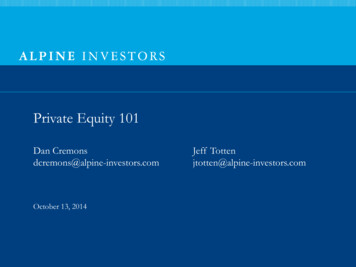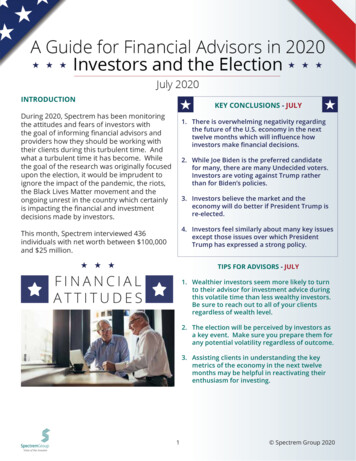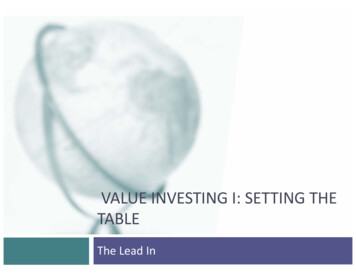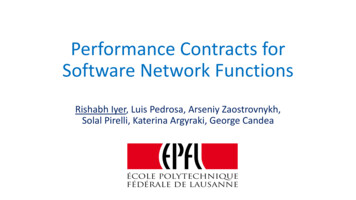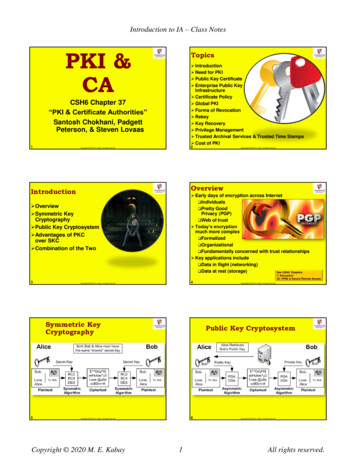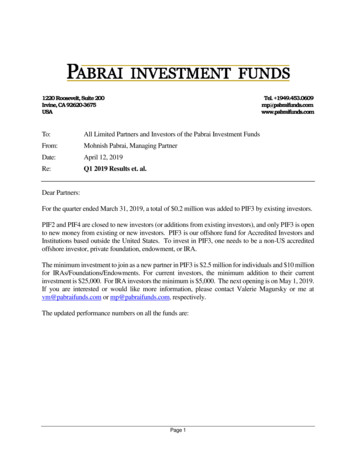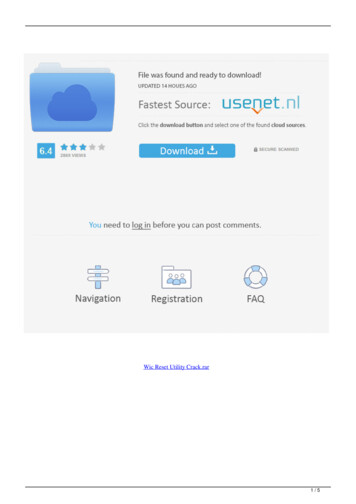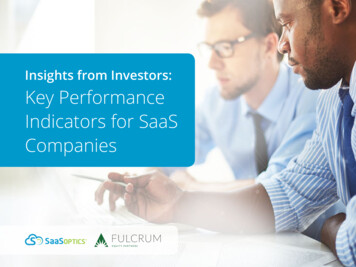
Transcription
Insights from Investors:Key PerformanceIndicators for SaaSCompanies
IntroductionTraditional financial metrics and legacy ERP systems don’t provideadequate insights into the performance and growth of SaaSbusinesses. That’s because these metrics and systems werecreated for companies selling “one-time” products and simplyTable of Contents2Introduction to SaaS KPIs3Part 1: Revenue GrowthPerformance Metrics8Part 2: Momentum and VelocityMetricsdon’t work for a recurring revenue business model.We understand — we’ve spent the last 10 years building oursubscription management platform to help SaaS businessesbetter manage the recurring relationships with their subscribersand streamline the entire customer life cycle.We teamed up with our Series A lead, Fulcrum Equity Partners,to give you a 360-degree view of the key SaaS metrics. Fulcrumis a growth equity firm focused on providing expansion capital,operating expertise and relationships to rapidly growing12 Part 3: Customer SuccessMetrics17 Next Steps: Moving Forwardand Measuring What Matterscompanies. Fulcrum invests in SaaS businesses — as far backas the early 2000s when they were called ASPs — partners withother SaaS funds and has sold companies to top strategics,18 Additional Resourcesincluding IBM and Oracle.Together, we’re leveraging our combined experience to shareinsights on the key performance indicators to scale a SaaSbusiness. The journey to reliable SaaS financial operations andfuture investment capital starts with measuring what mattersmost.2
Part 1:Revenue GrowthPerformance MetricsRevenue growth performance metrics provide visibility into the health of your business and its potentialfor growth. You’re likely familiar with these, but we’ll recap what they are just in case.Foundational metrics you should know: MRR and ARR ACV CAC, CLV and CAC Payback3
MRR or ARRMonthly Recurring Revenue (MRR) or Annual Recurring Revenue(ARR) is the value of the contracted recurring revenuecomponents of your term subscriptions normalized to a onemonth or annual period.We break ARR/MRR down into the following categories: New ARR/MRR – new sales to new customers. Expansion ARR/MRR – existing customers who expandedtheir subscriptions or licensed additional products ormodules. Contracted ARR/MRR – existing customers whodowngraded their subscription and/or reduced theirconsumption. Canceled ARR/MRR – existing customers who canceledtheir subscription.These components are frequently measured in both absolutevalue and relative value and are often presented in the contextof incremental changes from period to period.4
AverageContract ValueAverage Contract Value (ACV) is a measure of theaverage revenue generated per customer and isusually calculated on an annual basis.A growing or contracting ACV is a good indicator ofthe value you are providing to customers. This metricis also a critical input for your sales and marketingTable of Contentsplan and provides visibility into how many leads(MQLs) and opportunities (SQLs) are needed toachieve03your plan’s goals.05ACV 07Current ARRCurrent # of Customers0911135/55/
Customer Acquisition CostsThese metrics help you make important decisions about how you allocate sales andmarketing spend and are valuable in understanding how much your company is makingfrom each new customer and how long it takes to surpass the money you spent toacquire that customer. Customer Acquisitions Costs (CAC) – total sales and marketing resourcesassociated with acquiring a new customer. Customer Lifetime Value (CLV) – average revenue or profit a customer willgenerate before they churn. CAC Payback – the time it takes in months to recoup the cost of acquiring acustomer.You can also measure your CLV against CAC, which will tell you what you can expect tonet for every dollar you spend to acquire a customer.6
The Investor’s Point of View:Revenue Growth Performance MetricsMRR or ARRQuarter-over-quarter bookings growth provides valuable insights into the momentum and velocity of the business and growthinvestors consider it to be one of the best leading indicators of overall business performance.Average Contract ValueTracking ACV over time is valuable to understand evolving customer behaviors. It helps drive decision making for sales and marketingstrategies, customer success and retention strategies and your product road map.ACV is also a useful metric to measure the success of land-and-expand growth strategies, upsell initiatives and a company’s ability todeliver more and more value to customers.Customer Acquisition CostsCAC, CLV and CAC payback are used to track and measure the performance of sales and marketing teams and are also extremelyvaluable in understanding the efficiency of a company’s growth model.Investors will spend a significant amount of time in diligence analyzing the scalability of your sales and marketing organization, andthese metrics are great validations that additional investment in sales and marketing activities will drive value creation.7
Part 2:Momentum and Velocity Metrics How many leads are we adding to the top of the funnel?Where are my leads coming from?What does the pipeline look like over time?What are my funnel conversion rates?How productive is my sales team in closing deals?The answers to these questions will provide management teams and investors with higher predictability offuture performance and help build more accurate forecasts.Foundational metrics you should know: Lead Generation Pipeline Conversion MQLs SQLs8
LeadGenerationLead generation is the process of attractingquality prospects and moving them into thetop of your funnel.Consistently generating marketing qualifiedleads (MQLs) and sales qualified leads(SQLs) is essential for growing your SaaScompanies. A true marketing “mix” will havea variety of different methods for acquiringnew leads.Tracking which methods and demandgeneration activities are producing thebest results is important so you canweed out programs that aren’t workingand continually replace them with moreeffective ones.9
Pipeline ConversionOnce you’re generating leads, you’ll need to convert them into customers. A strong sales and marketing technology stack, sales processand content generation engine to engage and nurture buyers at every step of their buying process is critical for pipeline conversion.Building agile sales and marketing teams that can test, iterate and refine your marketing and sales funnel tactics to drive increasedconversion is critical.SEO/ Social Media/PPCTOP OF FUNNELClick-ThroughsBouncesMIDDLE OF FUNNEL(MQL)ReadersLeadsBOTTOM OF FUNNEL(SQL)ProspectsSalesCustomer SuccessRETENTIONCustomer Advocates10
The Investor’s Point of View:Momentum and Velocity MetricsLead Generation and Pipeline ConversionAccelerating rapid growth in a SaaS business involves lead generation, CRM, marketing automation and a strong understanding ofyour conversion metrics. Having an infrastructure in place to produce and track your pipeline of prospects and a history of convertingthose prospects into customers is critically important in raising capital.Investors are looking for businesses that truly understand their sales and marketing funnel with strong lead generation and pipelineconversion rates that provide visibility, comfort and high predictability of future revenue growth.11
Part 3:Customer Success MetricsAs a subscription business, establishing positive relationships with your customers is vital. From onboardingand implementation to adoption and support, every touch point can impact whether or not you retain thatcustomer over time. Measuring customer success and setting goals around those metrics is instrumental ingrowing your SaaS business.These metrics are indicators for measuring the health of your customer base: Churn and Retention Expansion Revenue Cohort Analysis12
Churn and RetentionChurn can happen for a multitude of reasons, but as one of the most important indicators of the health of your business, you needto understand why. As your company expands and the size of your subscription base grows, the revenue lost to churn can also grow,requiring more bookings from new customers to replace what was lost. This can be a significant drag on growth. Here are two formulascommonly used to calculate churn.Net Churn Gross Churn Sum of churn and contracted MRR - Sum of expansion MRRMRR at start of periodSum of churn and contracted MRRMRR at start of periodAnother common metric for analyzing retention is logo churn by replacing MRR in the formula above with number of customers. Highchurn usually indicates your product isn’t meeting customer needs and expectations. With insight into the factors driving churn, you cantake action, such as improving customer engagement and onboarding or making product tweaks that can improve customer retention.13
Expansion/Upsell RevenueGenerating revenue from existing customers is a good indicator ofwhether they are receiving value from your product and expandingtheir use. Expansion revenue includes customers who upgrade to amore robust plan or those who pay for additional users or features.When expansion revenue outpaces lost revenue from existingcustomers, you’ll reach net negative churn—also known as the holygrail of SaaS. At that point, your recurring revenue is expandingRevenuewithout adding new customers.Net NewGrowthNew ePrior YearNew ent Year14
Cohort AnalysisGrouping customers by product, vertical, sales channel,deal size, etc., also known as cohort analysis helpsuncover trends in specific customer groups.For example, if a large number of customers are churningin the first or second month, you may need to addressyour onboarding process. Emerging SaaS companiestypically have customers that vary in size, so cohortanalysis by deal size can highlight which “group” has theTable of Contentslowest churn rates.03 Introduction05 Get The Right Tools07 Connect All Your Data09 Work Smarter11 Go Mobile13 Simplify Reporting15 /1515/
The Investor’s Point of View:Customer Success MetricsChurn and RetentionInvestors pay very close attention to churn because customer retention is 95 percent of your revenue. Everything is amortized overtwo- to three-year contracts in a SaaS business.High retention and strong renewal rates are key value drivers and are crucial to increasing CLV, and it’s an area investors spend a lotof time focusing on during diligence.Expansion/Upsell RevenueIt takes significantly more time and resources to acquire and onboard a new customer than it does to retain and upsell existing ones.Investors look closely at expansion and upsell revenue metrics and ascribe high value to businesses that can grow organically byexpanding existing customer relationships.Cohort AnalysisAnalyzing customer behavior across various cohorts provides valuable insights into how different segments of your customers areinteracting with your product, sales and marketing teams.Customers have different needs, and understanding these needs across cohorts can help improve customer relationships, go-tomarket messaging, predict upsell/expansion opportunities and combat churn.16
Next Steps:Moving Forwardand MeasuringWhat MattersWhether you’re motivated by growth or by making moreinformed decisions about your business, the journey toreliable SaaS financial operations starts with measuringwhat matters.We know how challenging this journey can be becausewe’ve been in your shoes.That’s the reason we built SaaSOptics. We offer totalsubscription management, from order to invoice, tocash and renewal, and we are the only platform that canscale and deliver in-depth financial metrics and analysis,including MRR, ARR, ACV, CAC, cohort and CLV. SaaSOpticsis everything you need to run and grow your SaaS business,all in one place.Call us today at 678.710.8260 or email us atinfo@saasoptics.com for more information.Learn More17
Additional ResourcesDOWNLOADDOWNLOADDOWNLOADDOWNLOADLEARN MORE
A strong sales and marketing technology stack, sales process and content generation engine to engage and nurture buyers at every step of their buying process is critical for pipeline conversion. Building agile sales and marketing teams that can test, iterate and refine your marke
